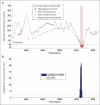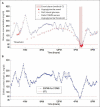Hypoglycemia prediction with subject-specific recursive time-series models
- PMID: 20167164
- PMCID: PMC2825621
- DOI: 10.1177/193229681000400104
Hypoglycemia prediction with subject-specific recursive time-series models
Abstract
Background: Avoiding hypoglycemia while keeping glucose within the narrow normoglycemic range (70-120 mg/dl) is a major challenge for patients with type 1 diabetes. Continuous glucose monitors can provide hypoglycemic alarms when the measured glucose decreases below a threshold. However, a better approach is to provide an early alarm that predicts a hypoglycemic episode before it occurs, allowing enough time for the patient to take the necessary precaution to avoid hypoglycemia.
Methods: We have previously proposed subject-specific recursive models for the prediction of future glucose concentrations and evaluated their prediction performance. In this work, our objective was to evaluate this algorithm further to predict hypoglycemia and provide early hypoglycemic alarms. Three different methods were proposed for alarm decision, where (A) absolute predicted glucose values, (B) cumulative-sum (CUSUM) control chart, and (C) exponentially weighted moving-average (EWMA) control chart were used. Each method was validated using data from the Diabetes Research in Children Network, which consist of measurements from a continuous glucose sensor during an insulin-induced hypoglycemia. Reference serum glucose measurements were used to determine the sensitivity to predict hypoglycemia and the false alarm rate.
Results: With the hypoglycemic threshold set to 60 mg/dl, sensitivity of 89, 87.5, and 89% and specificity of 67, 74, and 78% were reported for methods A, B, and C, respectively. Mean values for time to detection were 30 +/- 5.51 (A), 25.8 +/- 6.46 (B), and 27.7 +/- 5.32 (C) minutes.
Conclusions: Compared to the absolute value method, both CUSUM and EWMA methods behaved more conservatively before raising an alarm (reduced time to detection), which significantly decreased the false alarm rate and increased the specificity.
2010 Diabetes Technology Society.
Figures



References
-
- The Diabetes Control and Complications Trial Research Group. The effect of intensive treatment of diabetes on the development and progression of long-term complications in insulin-dependent diabetes mellitus. N Engl J Med. 1993;329(14):977–986. - PubMed
-
- UK Prospective Diabetes Study (UKPDS) Group. Intensive blood-glucose control with sulphonylureas or insulin compared with conventional treatment and risk of complications in patients with type 2 diabetes (UKPDS 33) Lancet. 1998;352(9131):837–853. - PubMed
-
- Eren-Oruklu M, Cinar A, Quinn L, Smith D. Adaptive control strategy for regulation of blood glucose levels in patients with type 1 diabetes. J Process Control. 2009;19(8):1333–1346.
-
- Bequette BW. Optimal estimation applications to continuous glucose monitoring. Proceedings 2004 American Control Conference; 2004. pp. 958–962.
Publication types
MeSH terms
Substances
LinkOut - more resources
Full Text Sources
Other Literature Sources
Medical

